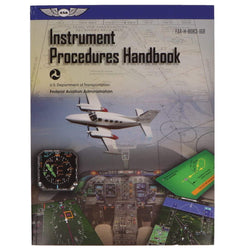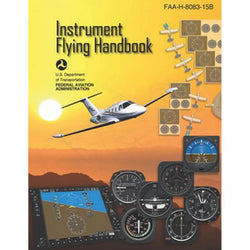You've made the switch to becoming an instrument-rated pilot, and now it's time to explore one of the most important tools for making a safe landing—the ILS (instrument landing system). For over half a century, this has been the cornerstone of flight safety for IFR pilots.
We want you to feel fully equipped to take on this challenging new journey, let us give you the full lowdown on the ILS!
Ready to get started? Let's go!
What is an Instrument Landing System?
An instrument landing system is one of the primary landing navigation aids used by pilots flying under instrument flight rules (IFR).
In simplicity, the ILS gives pilots instruction and guidance to make safe landings on the runway, even when visibility is limited. The ILS sends signals to instruments in the cockpit so that the pilot can stay on a predetermined course to get to the runway.
The FAA describes the ILS saying that it provides the aircraft with “precision vertical and horizontal navigation guidance information during approach and landing.”
They also note that, “associated Marker Beacons and/or Low Power Distance Measuring Equipment (LPDME) identify distance to the runway.”

How Does an Instrument Landing System Work?
If you're wondering "how does an ILS work", the two key physical components of the Instrument Landing System are the localizer and the glideslope. They are aided by marker beacons and the approach lighting system (ALS). Both the localizer and glideslope communicate with aircraft via radio beams and together they provide the navigational guidance that pilots need to safely land.
If the localizer is inoperative, the airfield is not authorized for ILS landings. An inoperative glideslope transmitter means that pilots can still fly a non-precision localizer instrument approach.
The Three ILS Categories
There are three categories of Instrument Landing Systems, each with their own minimums.
- CAT I: Most Instrument Landing Systems are Category I with a decision height of no less than 200 feet and visibility minimums of one-half mile or 2,400 feet of runway visual range (RVR).
- CAT II: Some airlines and corporate flight departments are FAA authorized to use Category II instrument landing systems. A Category II ILS has additional equipment, facilities, and pilot training which are required since the minimums are lower. Pilots landing using a Category II ILS have a decision height minimum of not less than 100 feet and 1,800 to 1,200 feet RVR is required.
- CAT III: The Category III ILS with its three subclasses is more rarely used and comes with very low minimums. A Category IIIa approach can have as low as a 50-foot decision height and down to a 700-foot RVR, while a Category IIIb allows an RVR down to just 300 feet.
The FAA created Category IIIc approaches but has yet to authorize them or certify any aircraft to make the approach that would allow a completely blind landing with 0 feet of runway visual distance required.
VHF Localizer
The localizer is a piece of equipment that is usually located 1,000 feet from the opposite end of the runway so it does not present a collision hazard to approaching aircraft.
The localizer transmits a VHF (very high frequency) signal from an antenna that is aligned with the centerline of the runway. The localizer transmits in the range between 108.10 and 111.95 MHz at a power of about 100 watts.
Pilots can pick up the localizer signal from a distance of approximately 18 nautical miles away and an altitude of 4,500 feet above the antenna.
The purpose of the localizer is to provide pilots with horizontal guidance to help them maintain alignment with the runway centerline throughout the final approach and landing. To do this, in addition to the primary radio signal, the localizer uses horizontal polarization and a different modulation frequency for each side of centerline.
A pilot who is lined up with the center of the runway will receive both a 90 Hz and 150 Hz signal simultaneously. If a pilot is too far to the left, they will receive only the 90 Hz signal. Too far to the right is indicated by 150 Hz. The acceptable course width that the localizer cues pilots to stay within is very narrow, usually between 3- and 6-degrees.
Glideslope Transmitter
The vertical component of the Instrument Landing System’s navigational guidance is provided by the UHF (ultra-high frequency) glideslope transmitter located about 750 to 1,250 feet down from the approach end of the runway.
The glideslope transmitter helps pilots stay on the appropriate glide path that will set them up to fly a straight, sloped descent line from the final approach fix (FAF) to the touchdown zone. The frequency range for the Glideslope transmitter is 329.3 to 335.0 MHz at a power of about 5 watts.
The glideslope transmitter uses vertical polarization and modulation signals to advise pilots when they are off course vertically. If a pilot is on the glideslope, they will receive both a 90 Hz and a 150 Hz signal simultaneously which will cancel each other out.
If a pilot is flying above the glideslope, they will receive only the 90 Hz signal. Flying below the glideslope is indicated by receiving only the 150 Hz signal.
The standard glide slope angle is 3-degrees, although it may be higher based on local terrain near the approach end of the runway. A 3-degree glideslope equates to a descent rate of roughly 500 feet per minute.
Marker Beacons
Depending on whether the ILS is used for Category I or Category II approaches, there will be one or two VHF marker beacons installed along the localizer course.
They fall under:
- Outer Marker
- Middle Marker
- Inner Marker
While all three beacons may not necessarily be used for an approach, the outer and middle beacons are used for Category I systems and an additional inner beacon in use as well for Category II.
Outer Marker: The outer marker (OM) is positioned 4 to 7 miles from the airport and indicates the point at which an aircraft flying the localizer will intercept the glide path.
Middle Marker: The middle marker (MM) is situated 3,500 feet from the landing threshold, on the localizer centerline where the glideslope centerline is 200 feet above the elevation of the touchdown zone.
Inner Marker: The inner marker (IM) is placed between the middle marker and landing threshold to mark the decision height point of a Category II approach glide path.
 How to Read an Approach Plate
How to Read an Approach Plate
An IFR approach plate is comprised of several important parts that a pilot will need to dissect and understand.
- #1. Lists the date the published approach is good until.
- #2. Marginal data, and pilot briefing information, such as the missed approach, frequencies, runwaylengths and airport elevation.
- #3. The plan view, showing fixes and procedure turn information
- #4. Profile view and minima. One of the most important parts of the chart. Provides altitudes, Glide Slope, Visual Descent Point.
- #5. Airport diagram, elevation and knots/time from FAF(Final Approach Fix) to MAP(Missed Approach Point).
- #6. Marginal data, such as the type of approach, the runway and the airport along with it’s code.
How to Fly an ILS Approach
You will need the ILS approach plate for the airport you intend to land at along with clearance from ATC to perform the landing if you are on a file IFR flight plan.
Make sure you are aware of the type of Approach Lights the airport uses since the lighting system can be a visual indicator of the presence of a runway.
- Brief the approach and set up your FMS or GPS. You will need to get current weather and ATIS information.
- Align your aircraft with the runway, Air Traffic Control can provide vectors, or you can use a procedure turn.
- Intercept the glideslope and use your Course Deviation Indicator (CDI)
- Descend towards the runway, watch your instruments and fly the needle. Use small corrections and avoid chasing the needle of the CDI.
- Once you reach the Visual Descent Point, if the runway isn't visible, execute the Missed Approach.
The FAA will want pilots to perform approaches according to Airmen Certification Standards.
Approach Lighting Systems (ALS)
While ILS approaches are initiated using solely radio guidance, as the pilot approaches the runway, they must make visual contact and transition to a visual landing.
The ALS provides pilots the directional, glide path, and distance lighting they need to make a smooth and safe transition from instrument to visual approach.
To tie it all together, here is a simulation of flying an ILS approach and how the ILS system works in flight.
 |
Gleim 2023 Instrument Pilot FAA Knowledge TestUsing Gleim's well-known method of information organization & presentation, Gleim's Instrument Pilot FAA Knowledge Test manual is the only tool users need to prepare for the FAA Instrument Rating, Instrument Flight Instructor, and Instrument Ground Instructor written exams. |
Want to learn more about IFR (Instrument Flight Rules)?
Our guides are designed to help student pilots become professional pilots and for private pilots to brush up on their knowledge and skills.
-
Lost Comms on IFR Flight (What to do & Procedures to Follow)
-
The Complete Guide to Aircraft Instruments [More Than Just the 6-Pack]
Did you find this article helpful?
Do you think we missed anything important? Let us know in the comments below!












